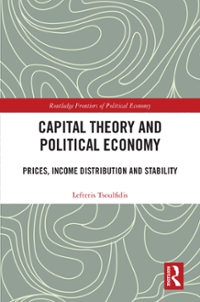Question
QUESTION 1 1.The study of inflation, unemployment rate and national income are part of: a)Global economics b)Macroeconomics c)Positive economics d)Microeconomics 2.An example of implicit cost
QUESTION 1
1.The study of inflation, unemployment rate and national income are part of:
a)Global economics
b)Macroeconomics
c)Positive economics
d)Microeconomics
2.An example of implicit cost for a firm is the:
a)Foregone payment in term of salaries to the owner of the firm
b)Payment of salaries and wages to the workers by the firm
c)Payment for raw materials used in production
d)Payment for utilities used in production
3.Government policies regarding taxes and expenditures are called:
a)Fiscal policies
b)Growth policies
c)Monetary policies
d)Supply side policies
4.A company received a bulk order of 100,000 pieces of scarves. She needs a worker to help her with the order. The demand for a worker is considered:
a)Joint supply
b)Joint demand
c)Derived demand
d)Competitive demand
5.The price elasticity of demand measures:
a)How often the price of a good changes
b)The slope of a budget curve
c)The sensitivity of supply
d)The responsiveness of the quantity demanded to the changes in price
6.Disposable income can be defined as:
a)The actual income received by households
b)Income received by households after deducting personal taxes
c)Income received by suppliers for their current contribution to production
d)None of the above
7.As an output increases, which of the following short run costs continues to decrease:
a)Average variable cost
b)Average fixed cost
c)Marginal cost
d)Average cost
8.Which of the following pairs is a substitute goods?
a)Pen and ink
b)Television and speaker
c)Tea and sugar
d)Cotton and wool
9.If a firm decides to produce no output in the short run, which of the following costs will be zero:
a)Total cost
b)Fixed cost
c)Variable cost
d)Average cost
10.Which of the following describes a monopoly firm?
a)Single seller
b)Many substitutes
c)No barriers to entry
d)Many sellers
11.Which of the following is true?
a)The relationship between price and quantity demanded is inverse or negative
b)The market demand curve is vertical
c)Price has no direct relationship with the quantity of demand
d)None of the above
12.Whenever the price of Good A decreases, the demand for Good B increases. Good A and Good B are?
a)Complement
b)Substitutes
c)Inferior goods
d)Normal goods
13.In calculating National Income, the construction of public hospital is classified as?
a)Investment expenditure
b)Government expenditure
c)Foreign direct investment
d)Government policies
14.The law of diminishing marginal return states that:
a)The demand for goods produced by purely competitive industries is down sloping
b)When more variable input is added, while the fixed input is not changing, the marginal product of variable input will eventually decline
c)A firm's competitive long run average cost will be U shaped
d)Short run production produces more output and give higher returns
15.Coca Cola and Pepsi are viewed as substitutes product. If the price of Coca Cola increases, what can be expected is:
a)Demand for Coca Cola to increase
b)Demand for Pepsi to increase
c)Demand for Pepsi to decrease
d)Demand for Coca Cola and Pepsi both increase
16.Which of the following statement is not related to economic problems?
a)What to produce?
b)For whom to produce?
c)Where to produce?
d)How to produce?
17.The main difference between microeconomics and macroeconomics is?
a)Microeconomics deals with individual parts of the economy, while macroeconomics studies the whole economic system
b)Microeconomics studies the whole economic system, while macroeconomics deals with individual parts of the economy
c)Microeconomics deals with the inflation, recession and interest rate, while macroeconomics focuses on government spending
d)Microeconomics only concerned with theories, while macroeconomics involves decision making
18.Money functions as a:
a)Medium of exchange
b)Measure of value
c)Store of value
d)All of the above
19.When output increases in smaller proportion than the increases in inputs, the returns to scale is:
a)Decreasing
b)Increasing
c)Negative
d)Constant
20.The unemployment rate generally __________ during recessions and generally _________ during expansions.
a)Increases; decreases
b)Decreases; increases
c)Increases; increases
d)Decreases; decreases
QUESTION 2
INSTRUCTION: ANSWER ALL QUESTIONS. STATE TRUE (T) OR FALSE (F).
(20 MARKS)
1.The demand for inferior goods will decrease as the income increases.
(TRUE / FALSE)
2.It is impossible for total product to be decreasing when marginal product is positive
(TRUE / FALSE)
3.Inflation can be defined as a decrease in the general price of goods and services.
(TRUE / FALSE)
4.The difference between economic profit and accounting profit is that the economic profit is calculated based on both implicit and explicit costs whereas accounting profit is calculated based on the explicit costs only.
(TRUE / FALSE)
5.Production function shows the relationship between wages and profit.
(TRUE / FALSE)
6.In the long run production, a firm has at least one fixed input.
(TRUE / FALSE)
7.Perfect Competition is defined as a market in which there are many buyers and sellers, the products are homogeneous, and sellers can easily enter and exit the market
(TRUE / FALSE)
8.Scarcity can be defined as human wants always greater than the limited resources. The theory of scarcity, it does not affect the rich people, it affects only the poor.
(TRUE / FALSE)
9.Monetary policy refers to the tools used by the government through the central bank to control the money supply.
(TRUE / FALSE)
10.Wages and salaries refer to the income that is received by the labour force for their service from the firms.
(TRUE / FALSE)
Step by Step Solution
There are 3 Steps involved in it
Step: 1

Get Instant Access to Expert-Tailored Solutions
See step-by-step solutions with expert insights and AI powered tools for academic success
Step: 2

Step: 3

Ace Your Homework with AI
Get the answers you need in no time with our AI-driven, step-by-step assistance
Get Started


